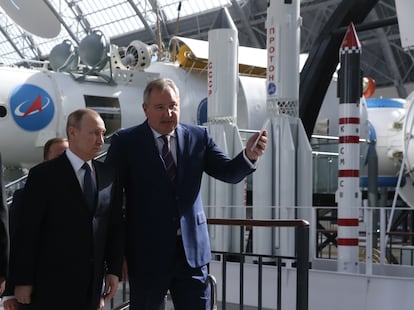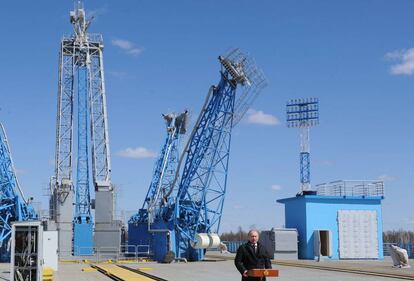Corruption, budget cuts and politicization break down Russia’s space muscle
The failure of its first mission to the Moon in 47 years has revived doubts about the Russian space industry, which is stifled by a lack of support both inside and outside the country


At the beginning of December of last year, one of the people responsible for the first mission to the Moon made by modern Russia — the former director of Roscosmos, Dmitry Rogozin (2018-2022) — was injured by an explosion, while celebrating his birthday in a restaurant in Donetsk.
Six months earlier, he had been fired for a long list of corruption scandals and the tension he had caused with other partners in the space race. At one point, he had even threatened to crash the International Space Station over Europe (it is kept aloft with Russian boosters). He was clearly more interested in politics than science, despite the fact that he ran the Russian Space Agency. Since his ouster, he has attempted to regain favor with the Kremlin, by emulating Wagner’s late owner Yevgeny Prigozhin with another “consulting” company. Rather than just mercenaries, however, he also wants to provide drones through a militia called Tsarskie Volki — the Tsar’s Wolves.
Months before his dismissal, in April 2022, Rogozin took to social media to claim that he had readjusted operations at a military rocket plant after discovering “a colossal loss of money.” “I’ve used a dirty broom on the employees,” was his response, when asked about the arrest of the head of the Roscosmos construction department, Maxim Mamsurov, for large-scale fraud.
Rogozin represents a drift that has taken place in the last decades of the Russian cosmonautics industry, the pride of the country that boasts an endless list of milestones: from putting the first man and the first woman in space, to sending up the first satellite and the first space station in the cosmos. Years after these glory days, Rogozin’s biggest achievement was more propagandistic than scientific — he released a film that was recorded in orbit, a space drama called The Challenge (2023).
On August 23, India became the first country to land near the inhospitable southern pole of the Moon. Prime Minister Narendra Modi celebrated the success of the Chandrayaan-3 mission at the BRICS summit in Johannesburg. Russian President Vladimir Putin, wasn’t in attendance, fearing an arrest warrant from the International Criminal Court that was placed on him for war crimes committed in Ukraine. Three days earlier, the Russian Luna-25 mission crashed while trying to be the first to reach the same area as the Indian craft.
Three resounding failures
The Luna-25 program was the third attempt by post-Soviet Russia to send a spacecraft to explore the cosmos. The first — Mars-96, designed in collaboration with Europe and the U.S. — disintegrated over the Pacific Ocean upon launch. And, in 2011, the Phobos-Grunt was due to head to Mars after suffering several years of delays, but was lost in Earth’s orbit due to a computer glitch. During its re-entry into the atmosphere, it was also destroyed.
On August 19 — just one day before it was scheduled to land — Roscosmos reported that the ship “ceased to exist” after experiencing “an abnormal situation.” The current head of the space agency — Boris Yurisov — explained that the device’s propulsion system was activated for 127 seconds, rather than for the 87 seconds calculated by its on-board control system when trying to slow its orbit around the Moon. An investigation is currently underway to clarify how this “deviation of the actual impulse parameters from the calculated ones” occurred.
“We have nothing to comment on, except that our instruments showed their viability during the flight and while orbiting the Moon. They worked until the end,” Lev Zelioni assured EL PAÍS. He is the former director and the current supervisor of the Russian Space Research Institute, one of the organizations that participated in the exploration program.
“The accident [that occurred during the] Luna-25 mission has been a great tragedy for the developers of the scientific instruments and for the entire institute,” Zelioni lamented.
The burden of sanctions
The investigation continues and the reasons for the accident are still unknown. A well-known Russian space enthusiast — Vitali Yegorov — speculated in an interview with the Latvian media outlet Vazhnye Istorii that the crash could have been caused by a problem with the mechanism that was responsible for locating the position of the spacecraft. The piece — which was supposed to be imported — ultimately had to be produced in Russia, due to sanctions imposed following the 2014 annexation of Crimea. Roscosmos rewrote the technical requirements to be on time for the launch date.

Moscow’s first mission to the Moon since 1976 had been planned since the early 2000s, before Russia illegally annexed Crimea and brought the military into the Donbas region in 2014. The original plan was for Luna-25 to be followed by two more missions, which would be culminated by the more complete exploration of the Moon with the Luna-27 module. However, the European Union completely disassociated itself from the program last year, due to Russia’s invasion of Ukraine.
Russian media outlet Agentsvo estimates — based on available public procurement sources — that the Luna-25 project cost a total of 12.6 billion rubles, or around $130 million. This cost is about $55 million more than the Indian program, but still a relatively modest figure for such a feat. For example, shooting the movie Barbie cost about $145 million. And, compared to the cost of invading Ukraine, the Luna-25 mission is equivalent to the price of 15 Ka-52 attack helicopters.
“Russia will continue to implement its lunar program. Of course, the failure of Luna-25 will affect it in one way or another… and there’s the possibility that the accident will force the leaders and the country’s industry to intensify work in that direction,” opined Alexander Zhelezniakov, a historian who specializes in cosmonautics and a member of the Russian Federation of Cosmonautics. “Russia remains a great space power, so its interests aren’t limited to certain areas — it will cover the entire spectrum of space activities,” the historian emphasized during an interview with EL PAÍS.
Another scandal damaged the image of the Russian agency this past March. Kazakhstan’s government froze the assets of a Roscosmos subsidiary based in the city of Baikonur: the Russian Land Space Infrastructure Operation Center. This was due to a dispute over a joint project — the production of Soyuz-5 Irtysh rockets — with Kazakh authorities accusing the Russians of not having done their part.
Lagging behind in satellites
The war and the sanctions will likely cause the Kremlin to rethink its space strategy. One expert notes that it’s “most likely that, in the near future, more attention will be paid to increasing the orbital constellations of remote sensing satellites, communications, meteorological apparatus and other satellites for applied purposes.”
In 2015, Russia began work on its own version of Starlink — Elon Musk’s satellite internet network. The Sfera program envisioned placing a swarm of 640 mini-satellites in Earth’s orbit by 2030, compared to the nearly 5,000 that the American company currently has up there (although Musk’s firm plans to have 12,000 in the future). These satellites have played key roles in the new nature of warfare, where intelligence-gathering and drones are vital, as Ukraine’s defense strategy has demonstrated.
Even before the war, however, Russia cut back on the program. In 2021, Roscosmos announced that the swarm would be reduced to 380 satellites, of which only 162 have been launched, barely 3% of the network put together by Musk.
Another unknown is Russia’s participation in the International Space Station (ISS), whose end is scheduled for January of 2031. The head of Roscosmos has promised that his country will fulfill its part of the program until 2028, although the uncertainty that has gripped Russia worries its partners. At the moment, the Russian segment controls the direction of the ship, and the former head of Russian space operations was only recently threatening to send it crashing down to Earth.
However, despite all of this controversy, the Russian scientific community defends the importance of space exploration not only for Russia, but for all of humanity.
“Practice has shown that the presence of stations in near-Earth orbit is, in fact, a necessary condition for space exploration,” Zhelezniakov affirms. “Not only [does this presence] offer practical benefits thanks to the research and experiments that are carried out [on the ships], but this is also the link that, in the coming years, will allow humanity to expand its habitat and begin to actively explore the circumlunar space, before moving on to other planets.”
The Kremlin announced the creation of its own national space station and its departure from the ISS in April of 2021, around the same time that the first troop movements began along the Ukrainian border. But this idea was already being considered back in 2014.

According to Vladimir Kozhevnikov — the chief designer of the Russian Orbital Station — the planning process behind this Russian station will conclude in 2023, while its first power module will be sent into orbit by 2027. It will be followed by four other parts — inspired by the ISS modules — until 2030. The plan is to have a relatively modest space station that doesn’t require the constant presence of a crew.
Yet, despite these big plans, the future is uncertain, especially in Russia. An American astronaut, Terry Virts, told The Guardian this past week how he peered at Earth from the ISS in 2015. They were then orbiting over the war in Donbas. Next to him was Aleksandr Samokutyayev. “We both looked at each other. It was a sombre moment. But we didn’t say a word,” Virts recalled.
On February 25, 2022 — just one day after the invasion of Ukraine began — the former cosmonaut Samokutyayev warned that “Russia has always been — and will be — a strong state capable of defending its point of view.” And, this past June, he decorated a Russian soldier wounded in combat: “When Russia announced a special military operation last year, Aleksei volunteered for the war zone in Ukraine. He showed courage and bravery. This is a worthy example of patriotism!” the cosmonaut stressed. Just over a decade before he was awarding honors, he was bestowed the title of Hero of the Russian Federation — the highest national decoration given out by the Kremlin. Until 2022, this recognition was more often meant for scientists, artists and athletes, rather than for soldiers.
Sign up for our weekly newsletter to get more English-language news coverage from EL PAÍS USA Edition
Tu suscripción se está usando en otro dispositivo
¿Quieres añadir otro usuario a tu suscripción?
Si continúas leyendo en este dispositivo, no se podrá leer en el otro.
FlechaTu suscripción se está usando en otro dispositivo y solo puedes acceder a EL PAÍS desde un dispositivo a la vez.
Si quieres compartir tu cuenta, cambia tu suscripción a la modalidad Premium, así podrás añadir otro usuario. Cada uno accederá con su propia cuenta de email, lo que os permitirá personalizar vuestra experiencia en EL PAÍS.
¿Tienes una suscripción de empresa? Accede aquí para contratar más cuentas.
En el caso de no saber quién está usando tu cuenta, te recomendamos cambiar tu contraseña aquí.
Si decides continuar compartiendo tu cuenta, este mensaje se mostrará en tu dispositivo y en el de la otra persona que está usando tu cuenta de forma indefinida, afectando a tu experiencia de lectura. Puedes consultar aquí los términos y condiciones de la suscripción digital.
More information
Últimas noticias
Sinaloa Cartel war is taking its toll on Los Chapitos
Venezuela hardens its ‘revolutionary state’ project amid pressure from Trump
Sydney Sweeney, the actress praised by Trump: ‘Women are up against what society wants them to be’
The Bolsonaro surname: An advantage or liability in Brazil’s 2026 presidential elections?
Most viewed
- Reinhard Genzel, Nobel laureate in physics: ‘One-minute videos will never give you the truth’
- Pablo Escobar’s hippos: A serious environmental problem, 40 years on
- Charles Dubouloz, mountaineering star, retires at 36 with a farewell tour inspired by Walter Bonatti
- Why we lost the habit of sleeping in two segments and how that changed our sense of time
- The fall of a prolific science journal exposes the billion-dollar profits of scientific publishing










































